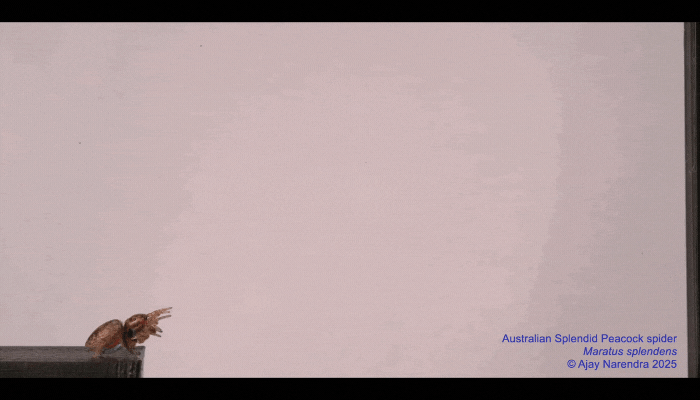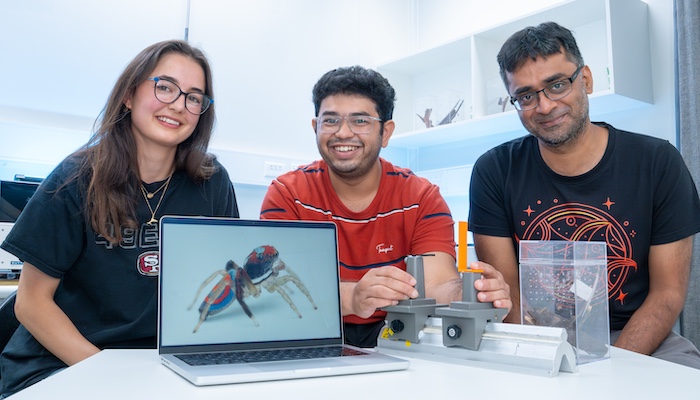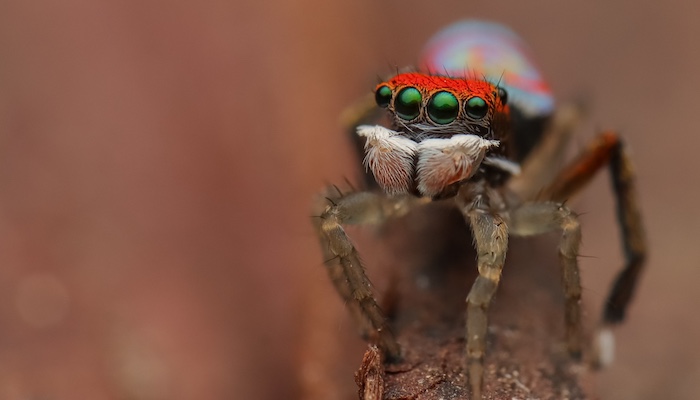Australia’s Peacock spiders, known for their vibrant courtship displays, have set a new record for the fastest acceleration ever recorded in jumping spiders.
Nature's gymnast: Using a semi-hydraulic system to power its jumps, this tiny male Splendid Peacock spider experiences forces 13 times greater than gravity during its precisely targeted leaps. Image: Ajay Narendra
Research by Macquarie University scientists published in the Journal of Experimental Biology this month, reveals the tiny spiders experience gravitational forces greater than those endured by fighter pilots during their high-precision jumps.
Associate Professor Ajay Narendra, from Macquarie University's School of Natural Sciences, led the research into Australian Splendid Peacock spiders (Maratus splendens), well-known for their vibrant colours and elaborate courtship dances.
This is the first detailed investigation of jump biomechanics in an Australian spider species and reveals remarkable differences in jumping abilities between male and female spiders.
“These spiders are so small you could fit four or five of them on your thumbnail. Males weigh just two milligrams - one of the lightest jumping spiders known - while females are six times heavier,” says Associate Professor Narendra.
“This gave us an opportunity to study how jumping kinematics varies between males and females, and what effect size has on jumping ability.”
Video study
Co-author Anna Seibel, a Master of Research student at Macquarie University, conducted detailed analyses of the jumps of the Peacock spiders using high-speed videography.
“We had the spiders jump across a four-centimetre gap from a take-off platform to a landing platform, which we filmed at 5000 frames per second using a high-speed camera,” says Seibel.
Jumping spiders employ a semi-hydraulic system to power their jumps. Unlike humans and other animals who contract and extend their muscles to create movement, spiders instead pump haemolymph - a fluid similar to blood that circulates through their bodies - into their legs to create the pressure needed for leg extension and jumping.
This remarkable system allows the Australian Splendid peacock spiders to achieve extraordinary acceleration despite their miniature size.
Evolutionary trade-off
The research uncovered an intriguing evolutionary trade-off involving the spiders’ third pair of legs. These specialised legs power their record-breaking jumps - but are also essential for male courtship displays.

Jump to it: Researchers Anna Seibel, left, Pranav Joshi, centre, and Associate Professor Ajay Narendra, left, set up a miniature jumping gym with time-lapse photos to measure spider jumps Image: Chris Barlow
“The third pair of legs is longer, darker and thicker than the other legs and has tufts of hair. Males extend these legs and wave them at females during courtship,” says co-author Pranav Joshi, a PhD student studying spider biomechanics.
But this dual-purpose adaptation also creates a survival challenge for the tiny show-offs.
“When a male is showing off to attract a female, it can't use its jumping leg to escape from predators. This makes the spider very vulnerable,” says Dr Joshi.
Extreme G-Force
Despite their delicate appearance, the tiny spiders have evolved remarkable ways to handle intense gravitational forces during jumps that can reach more than 13 times gravity – far greater than the 9G extremes experienced by fighter pilots.

Double duty: The same specialised third pair of legs used by this male Australian Splendid Peacock spider for its record-breaking jumps, is also an elaborate display tool during courtship. Image: Pranav Joshi
“For animals like us with more rigid bodies, the ability to withstand G-forces is far more limited than for spiders, whose soft and fluid-filled bodies deal with this pressure in a far better way,” says Associate Professor Narendra.
He attributes this to the spiders' lightweight build and evenly distributed internal pressure.
“Their low body mass reduces forces acting on their body. This also reduces stress on individual body parts as forces are distributed over their entire body,” says Associate Professor Narendra.
The findings could also have implications for robotics development.
“Jumping spiders have exceptional ability to control their jumps to reach specific targets – whether to land on surfaces or to catch small fast-moving insects,” says Associate Professor Narendra.
“Robotics researchers are likely to be inspired to build robots based on the semi-hydraulic systems of jumping spiders that have efficient goal-directed movements.”
Dr Ajay Narendra is an Associate Professor in the School of Natural Sciences, Macquarie University.



